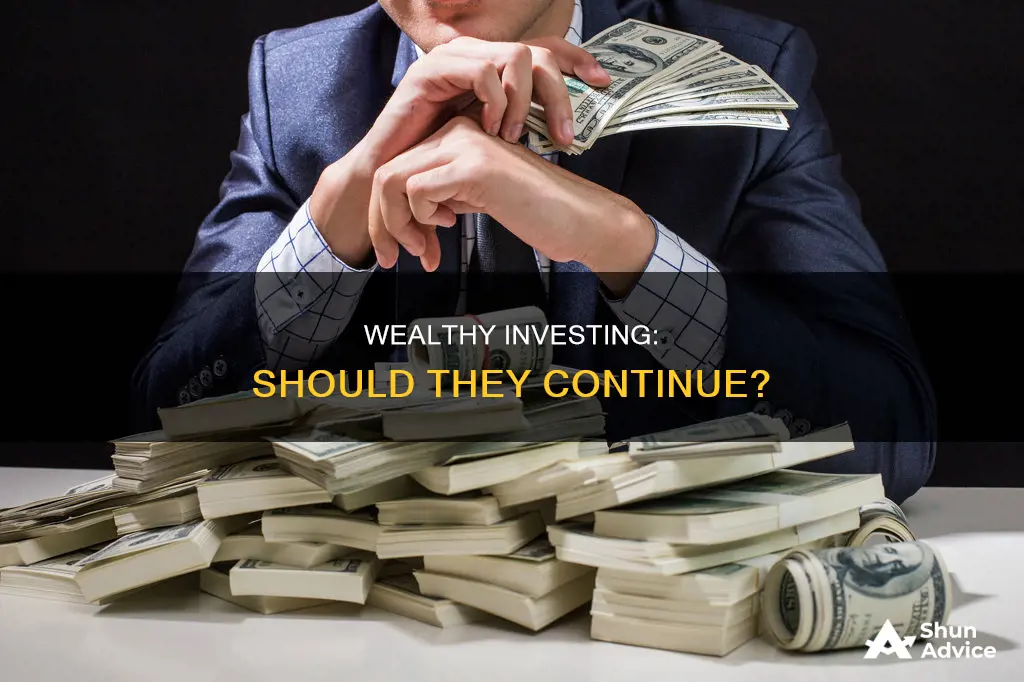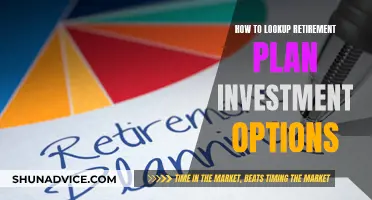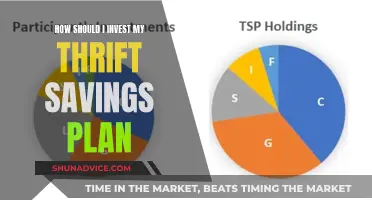
Should wealthy people continue to invest?
Wealthy people, or ultra-high-net-worth individuals (UHNWIs), are defined as those with a net worth of at least $30 million. This wealth is often composed of a mix of assets, including shares in private and public companies, real estate, and personal investments such as art, cars, and luxury items. UHNWIs understand the importance of having their money work for them and know how to take calculated risks. While there is no secret investment strategy to accumulating wealth, there are common practices that UHNWIs follow, such as investing in a diverse range of assets, including stocks, bonds, real estate, and alternative investments. Additionally, UHNWIs focus on their financial goals and long-term investment strategies rather than comparing themselves to others. They also periodically rebalance their portfolios to maintain the right mix of assets.
| Characteristics | Values |
|---|---|
| Stocks and shares | 26% of the average UHNWI's portfolio |
| Commercial property | 34% of the average portfolio |
| Bonds | 17% of the average UHNWI's portfolio |
| Private equity/venture capital | 9% of the average portfolio |
| "Investments of passion" (e.g. art, cars, wine) | 5% of the average portfolio |
| Gold | 3% of the average portfolio |
| Crypto | 2% of the average portfolio |
| Real estate | N/A |
| Public equities | N/A |
What You'll Learn

Diversifying investments
There are several ways to diversify a portfolio:
- By asset class: The three main asset classes are stocks, bonds and cash. Stocks offer the highest long-term gains but are volatile; bonds are income generators with modest returns, and cash is low on both risk and return. Other asset classes include real estate, commodities and alternative investments, which can aid in diversification as they often have a lower correlation to the stock market.
- Within asset classes: Diversification can be further broken down by factors such as industry, company size, creditworthiness, geography, investing strategy, and bond issuer. For example, within stocks, investors can diversify by intermingling companies of different sizes and from different sectors, as each business and stock is affected differently by the economic cycle.
- Beyond asset class: Diversification can also extend beyond traditional asset classes. Product types such as pensions, annuities and insurance can provide guaranteed income streams and returns, and reduce risk by spreading investment dollars among these different options.
It's important to note that diversification does not eliminate risk entirely. Market risk, which comes with owning any asset, cannot be avoided through diversification. However, asset-specific risks can be mitigated by diversifying investments.
Additionally, wealthy individuals may also invest in alternative assets, such as venture capital, leveraged buyouts, oil and gas, timber, and real estate. These assets tend to be less efficiently priced than traditional marketable securities, providing an opportunity to exploit market inefficiencies through active management.
Wealthy individuals also understand the importance of savings and how to take calculated risks. They focus on their own objectives and long-term investment strategies rather than comparing themselves to others. They also periodically rebalance their portfolios to achieve the right mix of stocks and bonds, and find opportunities in private markets.
Trump Investors: Winners or Losers?
You may want to see also

Investing in active funds
Active funds are those in which portfolio managers select investments based on an independent assessment of their worth, with the goal of "beating the market" and achieving better returns than certain standard benchmarks. Active investors purchase investments and continuously monitor their activity to exploit profitable conditions. They tend to look at the price movements of their stocks many times a day and are usually seeking short-term profits.
Wealthy people continue to invest in active funds for various reasons, which can change as they age and their attitudes towards money evolve.
In your 20s: Curiosity, Naivety, Access
Young investors may be curious about active funds and want access to them, especially if they have connections to such funds through their job. They may not be investing a lot, so higher fees are less of a concern.
In your 30s: Hopes and Dreams
As people gain more wealth, they may start dreaming of getting really rich. They hear stories of fund managers making huge returns and know that those extraordinary gains are often the result of concentrated bets rather than investing in index funds. Therefore, they may be inclined to follow suit with some of their capital.
In your 40s and beyond: Security and Capital Preservation
After potentially two decades of actively investing, people realise that there is a high chance that their active investments will underperform passive index investments. At this stage, they tend to have more experience, wealth, and wisdom, and may have better access to historically better-performing funds.
Older investors may appreciate having a fund manager dedicated to looking after their capital and may feel more comfortable with a manager who has a good track record and extensive experience. Since they may already have enough capital to generate a livable passive income stream, they may prioritise peace of mind over returns.
Additionally, active funds can provide better protection against losing money, especially during market downturns. Diversifying into active funds can be a way to manage risk and protect against big losses.
Limitations of Active Funds
Active investing can be costly due to the potential for numerous transactions, and investors may have to pay management fees regardless of the fund's performance. Active funds often set minimum investment thresholds, which can be high.
Advantages of Active Funds
- Flexibility: Active managers are not restricted to following a specific index and can invest in stocks they believe will perform well.
- Hedging: Active managers can use various techniques to hedge their bets, such as short sales or put options, and can exit specific stocks or sectors when the risks become too high.
- Tax management: Advisors can tailor tax management strategies to individual investors, such as selling investments that are losing money to offset taxes on winning investments.
Starbucks: Worth Your Investment?
You may want to see also

Building inflation-resistant portfolios
Building an investment portfolio that can withstand inflation is a challenging task for investors. Here are some strategies for constructing inflation-resistant portfolios:
Diversification Across Asset Classes
Diversifying your investments across various asset classes is crucial for building an inflation-resistant portfolio. This includes allocating a portion of your wealth to equity investments, such as commodity producers and real estate investment trusts (REITs). At the same time, it is essential to include inflation-resistant fixed-income investments like Treasury Inflation-Protected Securities (TIPS) and shorter-duration bonds.
Equity Investments
When it comes to equity investments, consider the following:
- Commodities and Commodity-Producer Equities: Energy, materials, and other commodities tend to have a positive correlation with inflation. Investing in commodity-producing companies can provide a hedge against inflation.
- Value Stocks: According to Dirk Hofschire, value stocks often have exposure to commodities and commodity producers, making them a potential inflation hedge.
- US and International Stocks: Diversifying across geographies can be beneficial, as inflation may affect different regions differently.
- Real Estate Investment Trusts (REITs): Property prices and rents tend to increase during inflationary periods, making REITs a popular inflation hedge. They offer exposure to the real estate market and can provide stable income through dividends.
Inflation-Resistant Fixed-Income Investments
In terms of fixed-income investments that can resist inflation, consider the following:
- Treasury Inflation-Protected Securities (TIPS): TIPS are a type of US Treasury bond designed to protect against inflation. The principal value of TIPS adjusts based on the inflation rate, and the interest received also rises accordingly.
- Shorter-Duration Bonds: Shorter-duration bonds are less sensitive to interest rate changes and can provide a measure of protection against inflation.
Other Strategies
In addition to the above, there are other strategies to consider when constructing an inflation-resistant portfolio:
- Reducing Exposure to Interest Rate-Sensitive Investments: Certain investments, such as long-term Treasury bonds, are highly sensitive to interest rate changes. Reducing exposure to these investments can help mitigate the negative impact of rising interest rates during inflationary periods.
- Investing in Business Bank Loans: Investing in floating-rate debt, such as business bank loans, can be a good strategy to avoid the negative impact of inflation on fixed-rate loans. Floating-rate debt allows investors to earn higher interest when rates rise.
- Focus on Companies with Pricing Power: Invest in companies that can pass along higher costs to customers due to strong demand for their products. This helps protect their profits during inflationary periods.
- International Diversification: Inflation may affect different countries differently. Diversifying your portfolio internationally can provide a hedge against inflation, especially if inflation is more severe in your domestic market.
- Private Markets: Ultra-high-net-worth individuals (UHNWIs) often find investment opportunities in private markets, such as private equity and angel investing, which may be overlooked by investors focused solely on public markets.
Investments: Strategies for Persuasion
You may want to see also

Investing in luxury items
Luxury items have long been an attractive alternative investment option for wealthy people, especially those who live in emerging countries where financial markets and domestic currencies are unstable. The luxury market is expected to grow by 4 to 6% in 2019, largely driven by Chinese consumers who accounted for 33% of total luxury industry sales in 2018.
However, investing in luxury items is not without its risks and challenges. Here are some things to consider when investing in luxury items:
Research and Expertise
It is important to have a deep understanding of the item's history, tradition, and potential for financial rewards. Some luxury items, such as limited-edition sneakers, vintage watches, handbags, and classic cars, tend to increase in value over time due to their prestige, scarcity, and cultural significance. On the other hand, some luxury goods may lose value due to overproduction or a decline in brand image.
Diversification
Diversifying your investments across different asset classes is crucial to minimizing risk. Luxury items can be a part of a well-diversified portfolio that includes stocks, bonds, real estate, and commodities.
Long-term Perspective
Investing should be approached with a long-term perspective, focusing on your financial goals rather than short-term market fluctuations.
Risk Tolerance
Evaluate your risk tolerance before investing. Luxury items can be volatile and subject to trends, brand image, and cultural influences, making them a risky gamble for those without a clear investment strategy.
Storage and Maintenance
Some luxury items, such as paintings, vintage cars, and wines, require proper storage and maintenance to retain their value. Serious investors may consider insurance and professional storage options to protect their investments.
Ethical and Environmental Concerns
When investing in luxury items, it is essential to be mindful of the ethical and environmental impact of the luxury industry. This includes concerns such as the treatment of animals, labour conditions, and the environmental impact of sourcing raw materials.
Status vs. Investment
It is important to distinguish between purchasing luxury items as a status symbol and investing in them for financial gain. Ensure that your investments align with your financial goals and risk tolerance, and that you have a solid understanding of investment principles.
Examples of Luxury Items to Invest In
Some specific examples of luxury items that have proven to hold their value or appreciate over time include:
- Luxury handbags by Hermès, Chanel, and Louis Vuitton.
- Vintage watches by Rolex, Patek Phillipe, Audemars Piguet, and Hublot.
- Classic cars, such as a 1955 Mercedes-Benz Uhlenhaut Coupé, which sold for a record €135 million in 2022.
- Fine art, including paintings and sculptures by well-known artists.
- Jewellery, particularly diamonds and coloured gemstones.
- Wine, which has been a collectible investment since the 19th century.
- Yachts and supercars, which can provide a luxurious lifestyle while also holding their value if properly maintained.
AI-Assisted Investing: The Future of Finance
You may want to see also

Investing in private equity
Private equity is a form of investment that takes place outside of the public stock market, allowing investors to gain an ownership stake in private companies. It is an alternative investment class that involves investing in or acquiring private companies that are not listed on a public stock exchange.
Private equity funds are pooled investments offered by private equity firms, allowing a group of investors to combine their assets to invest, typically in a company or business. The funds raised are used to develop new products and technologies, expand working capital, make acquisitions, or strengthen a company's balance sheet.
Who can invest in private equity?
To invest in private equity, one must also be an accredited investor, with a net worth of over $1 million or an annual income of at least $200,000 in the last two years.
Private equity firms manage and invest the pooled capital from investors through private equity funds. These funds then invest in various private equity instruments, such as buyouts or venture capital.
When investing in a private equity fund, investors become limited partners. They supply the capital but are not responsible for managing the company or making improvements. Instead, the private equity firm handles these tasks and sells the company when the time is right. Limited partners receive a return on their investment when the company is sold, typically taking about 20% of the profits, while the rest is split among them based on their contribution.
Wealthy individuals are often attracted to private equity investments because they offer the potential for higher returns than the public market. Private equity valuations are not influenced by the larger market, and private companies have more flexibility in their accounting practices.
Additionally, private equity allows investors to diversify their portfolios and take on more risk. It is an opportunity to invest in early-stage, high-risk ventures, particularly in sectors such as software, healthcare, telecommunications, and biotechnology.
There are a few ways to invest in private equity:
- Directly through private equity firms: Investors can work with private equity firms that have their own investment minimums, areas of expertise, and exit strategies.
- Private equity exchange-traded funds (ETFs): These ETFs offer exposure to publicly listed private equity companies, providing a way for non-accredited investors or those who cannot meet the minimum requirements to participate in private equity.
- Funds of funds: This approach involves investing in a fund that holds shares of multiple private partnerships investing in private equities, offering greater diversification and potentially lower risk.
- Special Purpose Acquisition Companies (SPACs): Investing in publicly traded shell companies that make private equity investments in undervalued private companies, although this option can be risky due to a lack of diversification.
- Crowdfunding: A recent development where individual investors contribute smaller amounts to raise capital for new ventures, but these investments are highly risky.
Risks of private equity
Private equity investments are considered very speculative and risky. There is a chance that the companies invested in may fail, and investors could lose their money. Private equity funds that cater to smaller investors may have higher fees, reducing returns. Additionally, the limited history of some private equity investment vehicles makes it challenging to compare them to other investments.
Investors should also be prepared to hold their private equity investments for the long term, typically at least ten years. Private equity is highly illiquid, and it may take time for companies to emerge from the acquisition phase, become profitable, and be sold.
Cola-Cola Investors: Who's Involved?
You may want to see also
Frequently asked questions
Ultra-high-net-worth individuals (UHNWIs) avoid common investment mistakes such as only investing domestically, only investing in intangible assets, and keeping up with the Joneses. They understand the importance of savings and investing basics, and know how to take calculated risks. UHNWIs also periodically rebalance their portfolios to maintain the right mix of stocks and bonds.
Wealthy people often invest in actively-run funds such as hedge funds, venture capital, venture debt, private equity, and specialty funds. They also invest in alternative assets like real estate, oil and gas, timber, and art. Additionally, they may allocate their wealth towards primary and secondary homes, private equity, commercial property, and "investments of passion" like art, cars, and wine.
The approach to investing in active funds may vary depending on the age and life stage of an individual. In their 20s, it may be driven by curiosity and access. In the 30s, it may be influenced by hopes and dreams of significant wealth. In the 40s and beyond, the focus may shift to security and capital preservation, with a greater emphasis on experienced fund managers and established track records.







